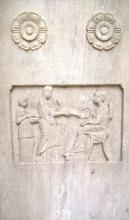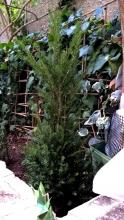By Eirini Tsotsou on March 02, 2018
This is a recipe for homemade pitta bread to be used as an offering to Goddess Hekate.
By Constantinos Nt... on March 02, 2018
Necropolis means the city of the dead. The archaeological place of Kerameikos in its biggest part is a necropolis, a place associated with death, religious practices, and art. For the first time, I will present info about Hekateion, the temple of Hekate in necropolis, and a Triangular Hiero of an unknown Goddess, standing in three ways crossroads, next to the way of Eleusis.
By Constantinos Nt... on March 02, 2018
Strophalos or Iynx is an ancient hellenic symbol dated before 2300 b.C. It was connected with the Goddess Hekate and later with Her aspect of Cosmic Soul, sending the Ideas from the Paternal God to the Creator God. Strophalos, triskelion, gammadion-tetraskelion and labyrinth are symbols that look like each other but the uses of strophalos are quite different. Through the help that was provided by the ancient Hellenes writers from Xenophon to Proclus, Damascius and Michael Psellos we will discover the uses, the form and the idea behind the magickal tool of the Witches-Theurgists of Hekate.
By Constantinos Nt... on March 02, 2018
In PGM IV 1716 lies a very effective binding spell called the Sword of Dardanos, the man who founded the mysteries in Samothrace. The island is associated with the Goddess Hekate. It starts with an invocation to the God who created the universe. I have translated and it can be used as a strong invocation to Hekate Soteira or Hekate Panopaia or Hekate Pasikrateia and calling the aspects of Axis Mundi and Queen of the World.
Due to the nature of the ancient invocations, the Witch should have a deep connection with the Goddess, to make the invocation with all of his emotions and vibrating the vowels and pronouncing correctly the voces magicae with all of the energy.
By Constantinos Nt... on March 02, 2018
I have already written an article about this subject but I want to expand and share another spell from PGM VII 429-458 In that spell Osiris is called with voces magicae implying their secret names. The interesting thing is that the spell is short and quick but it also requires knot magick if you release the katadesmos in special places, using again the famous voces magicaes ASKEI KAI TASKEI (as the ancient text writes).
This binding spell is very powerful as the ancient text intones. It can cause illness, make enemies, destroy and alter a situation, so use it to promote good magick according to the wiccan rede. Take a lead tablet from a water pipe of cold water. Write with a headless needle made of bronze:
By Constantinos Nt... on March 02, 2018
Hekate in Necromancy by Loukianos
By Constantinos Nt... on March 02, 2018
Yew or Taxus baccata is one of the trees associated with Hekate, necromancy, magickal wands etc. In this article I will present some info for growing that tree and its magickal properties. My purpose is to give you all the info you will need to have a yew friend in your yard. Just go to your plant store, ask Taxus baccata, buy some biological calcium, 2-3 handfulls of rocks, read this article and plant your yew.
By Constantinos Nt... on March 02, 2018
By Constantinos Nt... on March 02, 2018
Goddess Hekate. The invocation I am going to write derives from the PGM XII 238-245. It is an invocation to the almighty God, but I have modified it slightly to invoke the Goddess Hekate. The invocation is very beautiful, truely poetic. I have added the invocation to a well structured ritual, for anyone who wants to follow it or modify it according to its magickal tradition.
By Constantinos Nt... on March 02, 2018
Katadesmoi in plural, katadesmos in singular are an ancient hellenic magickal technique. It requires a lead tablet and a nail. The desired purpose is simply written in the lead and then it is fold in half and with a nail on the center it is bound. The instructions of how to make a lead tablet efficently for magickal uses could be found in ancient papyri and ancient tablets.
Pages


















It amazes me how so many traditions follow these ancient protocols and roles,